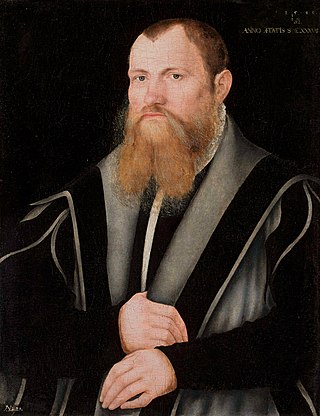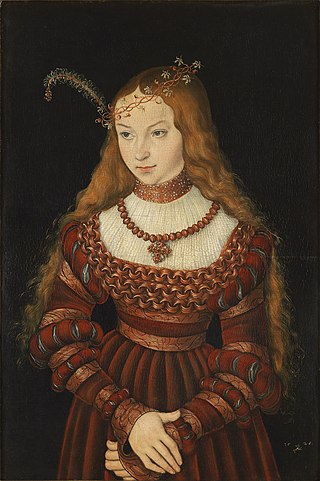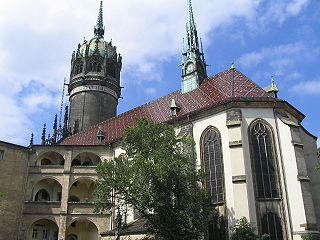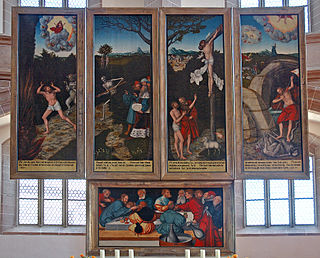
Wittenberg, is the fourth-largest town in Saxony-Anhalt, Germany. Wittenberg is situated on the River Elbe, 60 kilometers (37 mi) north of Leipzig and 90 kilometers (56 mi) south-west of Berlin, and has a population of 46,008 (2018).

Lucas Cranach the Younger was a German Renaissance painter and portraitist, the son of Lucas Cranach the Elder and brother of Hans Cranach.

Lucas Cranach the Elder was a German Renaissance painter and printmaker in woodcut and engraving. He was court painter to the Electors of Saxony for most of his career, and is known for his portraits, both of German princes and those of the leaders of the Protestant Reformation, whose cause he embraced with enthusiasm. He was a close friend of Martin Luther. Cranach also painted religious subjects, first in the Catholic tradition, and later trying to find new ways of conveying Lutheran religious concerns in art. He continued throughout his career to paint nude subjects drawn from mythology and religion.

John Frederick I, called the Magnanimous, was the Elector of Saxony (1532–1547) and head of the Schmalkaldic League.

Sibylle of Cleves was electress consort of Saxony.

The Protestant Reformation during the 16th century in Europe almost entirely rejected the existing tradition of Catholic art, and very often destroyed as much of it as it could reach. A new artistic tradition developed, producing far smaller quantities of art that followed Protestant agendas and diverged drastically from the southern European tradition and the humanist art produced during the High Renaissance. The Lutheran churches, as they developed, accepted a limited role for larger works of art in churches, and also encouraged prints and book illustrations. Calvinists remained steadfastly opposed to art in churches, and suspicious of small printed images of religious subjects, though generally fully accepting secular images in their homes.

All Saints' Church, commonly referred to as Schlosskirche to distinguish it from the Stadtkirche of St. Mary's, sometimes known as the Reformation Memorial Church, is a Lutheran church in Wittenberg, Saxony-Anhalt, Germany. It is the site where, according to Philip Melanchthon, the Ninety-five Theses were posted by Martin Luther in 1517, launching the beginning of the Protestant Reformation.

John, known as John the Steadfast or John the Constant, was Elector of Saxony from 1525 until 1532 from the House of Wettin.

Meissen Cathedral or the Church of St John and St Donatus is a Gothic church in Meissen in Saxony. It is situated on the castle hill of Meissen, adjacent to the Albrechtsburg castle and forms a critical centrepiece of the iconic Meissen skyline overlooking the River Elbe in the valley below.

The Last Supper of Jesus and the Twelve Apostles has been a popular subject in Christian art, often as part of a cycle showing the Life of Christ. Depictions of the Last Supper in Christian art date back to early Christianity and can be seen in the Catacombs of Rome.

The Stadt- und Pfarrkirche St. Marien zu Wittenberg is the civic church of the German town of Lutherstadt Wittenberg. The reformers Martin Luther and Johannes Bugenhagen preached there and the building also saw the first celebration of the mass in German rather than Latin and the first ever distribution of the bread and wine to the congregation – it is thus considered the mother-church of the Protestant Reformation. In 1996, it was inscribed on the UNESCO World Heritage List along with Castle Church of All Saints (Schlosskirche), the Lutherhaus, the Melanchthonhaus, and Martin Luther's birth house and death house in Eisleben, because of its religious significance and testimony to the lasting, global influence of Protestantism.

Crucifixion is an oil painting by German artist Lucas Cranach the Elder. One of many versions of the subject painted by Cranach, this one, created in 1532, is now in the Indianapolis Museum of Art.

Sophie of Mecklenburg, also spelled Sophia was a German noblewoman. She was a Duchess of Mecklenburg by birth and by marriage Electoral Princess of Saxony.

The church of St Peter and Paul in Weimar, Germany, is also known as Herderkirche after Johann Gottfried Herder. It is the most important church building of the town, and is called Stadtkirche, opposed to the courtly Schloßkirche. It has been the church of a Lutheran parish since 1525, after the Reformation. The church is part of the World Heritage Site Classical Weimar, together with other sites affiliated with the Weimar Classicism movement. Inscribed on the World Heritage List in 1998, these sites bear testimony to the cultural importance of Weimar during the late 18th and 19th centuries and the outstanding architecture that arose in response to the cultural values of the time.

The Church of the Holy Cross is a Lutheran church in the centre of Hanover, the capital of Lower Saxony, Germany. A Gothic hall church, it is one of three churches in Hanover's old town – the other two being Market Church and Aegidien Church, although the latter is now a war memorial.

Lutheran art consists of all religious art produced for Lutherans and the Lutheran churches. This includes sculpture, painting, and architecture. Artwork in the Lutheran churches arose as a distinct marker of the faith during the Reformation era and attempted to illustrate, supplement and portray in tangible form the teachings of Lutheran theology.

Law and Grace is considered one of the most important paintings by Lucas Cranach the Elder. This work, in the collection of the National Gallery in Prague, is one of the two oldest known versions of this theme and was executed in 1529. It is also called the Prague type and provided the model for a series of other paintings including an early-16th-century copy that is also kept in the Prague National Gallery's collection of Old European art. It is the best-known and most influential allegory depicting the fundamental tenets of Luther's reform of the church.

The Torgauer Altar, Torgau Altarpiece or Altarpiece of the Holy Kinship is a triptych altarpiece painted by Lucas Cranach the Elder in 1509.

The Schneeberg Altarpiece is a Lutheran winged altarpiece created in 1539 by Lucas Cranach the Elder for the Church of St. Wolfgang in Schneeberg in Saxony, Germany. The altarpiece was commissioned in 1531–1532 by the Elector of Saxony John I of Saxony and installed in the church in 1539, making it the first Protestant altarpiece of Reformation which is considered a Saxon masterpiece of art.

Wittenberg Cranach Altarpiece is one of the major Lutheran winged altarpieces created by Lucas Cranach the Elder and his son Lucas Cranach the Younger for the Evangelical Lutheran City and Parish Church of St. Mary's in Wittenberg, Germany. The altarpiece depicts the key figures of Lutheranism associated with the parish church of Wittenberg.



























